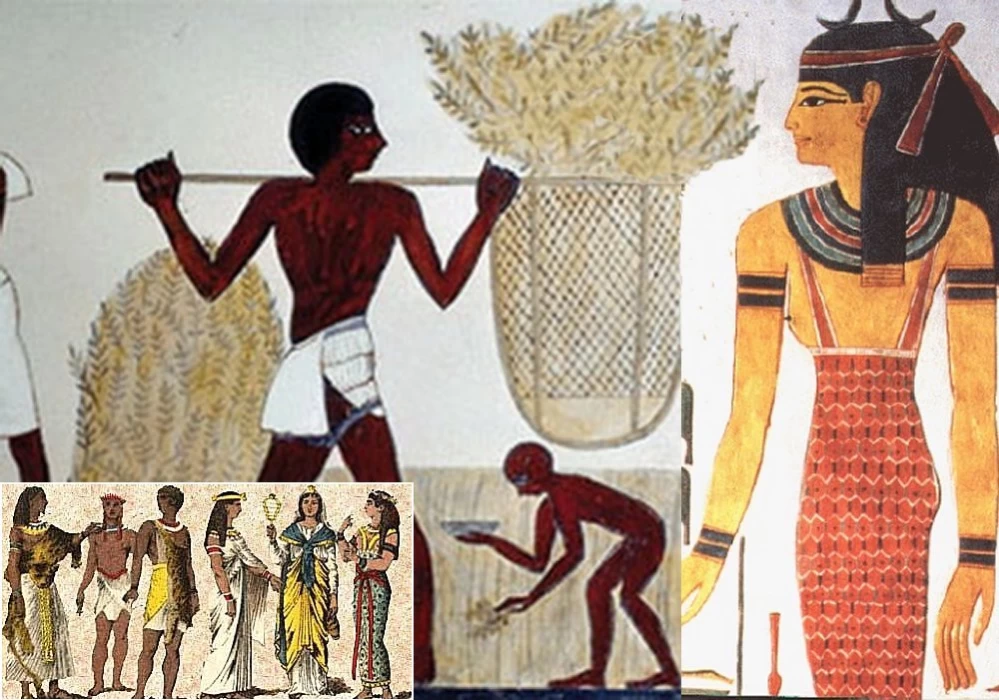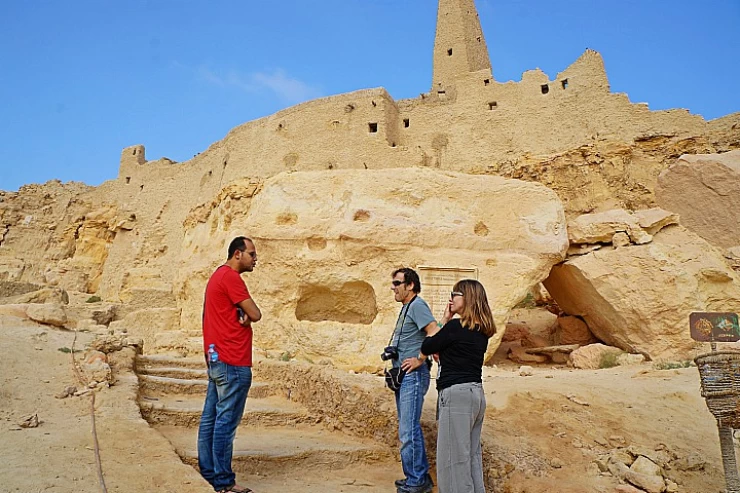
古埃及的服装
古埃及服装的贡献:政策、文化和历史的简要分析古埃及的服装在理解世界上最复杂的文明之一的社会、文化和宗教关系方面具有巨大的分量。 服装在古埃及人的生活中起着至关重要的作用;它不仅仅是为了复盖身体。 相反,它意味着社会阶层,性别,职业和宗教,所有这些都与周围环境和尼罗河人民发展的复杂文明相协调。
1. 材料:亚麻是首选面料
在古埃及,最流行和众多的纺织品之一是亚麻亚麻布,主要种植在尼罗河畔。 埃及的高温使人们不可避免地要穿轻而多孔的材料;因此,亚麻布成为最合适的材料。 尽管如此,用亚麻植物制作亚麻的过程相当劳动密集,因为它涉及浸泡植物,将其捣碎以检索更少的股线,最后是来自这些股线的纱线。
Zibellina esdromis优质亚麻特别受到贵族精英的欢迎。 最先进的,被称为"宫殿亚麻布",相当轻,但稳定,有光泽,有点透明,这表明它是为富裕阶层设计的。 贵族和祭司,包括法老,穿着最精致和完美的白色亚麻布服装,由于其无瑕疵的外观和精神方面,这也是为了皇室,而下层阶级穿着最破烂和粗糙的织物。
2. 法老和贵族的服装
精英们所穿的衣服反映了他们的地位、财富和对敬虔的信仰。 作为尘世的神,女王和法老穿着充满各种形象的时尚服装元素。 法老所穿的最受欢迎的服装之一是"shendyt",这是一条量身定做的百褶裙,上面有金色和宝石装饰。 它被一个装饰性的腰带固定在适当的位置,有时还穿着一件精心制作的长袍或夹克参加活动。
法老还有一件几乎是国王雕像的头饰,称为"名字",这是一种包裹头部并绑在后面的条纹织物。 所有这三个,连同假胡子,国王的头饰,并冠无论是埃及的白色或红色的王冠或埃及的双冠—权威和权力的标志,只是它是王权。
他们穿着与法老相似的衣服,但不那么炫耀。 更富有的男人和女人戴着复杂的项链,其中包括黄金和有色宝石。 她们的服装经过精心设计,以展示她们的社会阶层,女性经常穿着由优质亚麻布制成的紧身护套。
3. 工人阶级的服装
当精英们展示他们华丽的服装时,绝大多数埃及人口,包括农民,劳工,工匠和仆人,都穿上了更简单的衣服。 工人阶级的男人大多穿着简单的腰布或及膝粗麻短裙。 妇女穿的中山装也不例外,是专门为方便妇女的家庭和日常活动而设计的。
尽管有简单的衣服,很明显,他们花了时间和精力在他们的样子。 所有社会阶层的埃及人的清洁和一般外观都很重要,这可以归因于他们每天使用香水,油和化妆品作为他们的穿衣守则的一部分。
4. 宗教及礼仪服装
宗教信仰和习俗渗透到古埃及日常生活的各个方面;因此,在宗教和礼仪活动中穿着的服装描绘了社会的面貌。 为了表达他们的圣洁和他们所扮演的神的角色,祭司们穿着亚麻布白袍。 大多数大祭司都披着豹皮斗篷,在仪式期间穿着长袍的胸围区域,以表示与神灵的亲近。
神的礼服通常以非常精致和昂贵的服装为特征,有些像女神哈索尔,甚至穿着详细的护套礼服。 使用实用的动物皮和羽毛以及装饰件背后的意义是呼吁神圣的存在和他们的善意。
5. 珠宝:财富和保护的装饰
此外,如果没有装饰件,古埃及的服装就不完整。 对古埃及人来说,珠宝的用途不仅仅是装饰;它被认为是一种抵御黑暗势力的护身符。 每个人,无论等级如何,都用复杂的珠宝装饰和装饰自己,如颈饰,耳朵装饰,手腕和脚踝复盖饰物,甚至手指带。
戒指,耳环,项链和其他种类的珠宝通常是非常昂贵的东西,因为它们是由黄金和其他宝石为富人阶层制成的,而下层阶级在装饰性铜,青铜或彩色釉面珠 在人类历史上,当不同的文明蓬勃发展并留下宝贵的文物时,护身符也在古埃及人中得到了广泛的应用。 它们不仅仅是戴在项链或手镯上的装饰性魅力,这是当时的时尚; 他们还代表了神、动物和其他被认为在生与死中给予保护的神圣事物。
6. 化妆品和发型:增强美丽和力量
古埃及服装面临的另一个障碍是化妆。 不仅女性,而且男性首先使用kohl-一种黑色铅矿粉-来装饰他们的眼睛,但主要是为了保护他们免受耀眼的阳光。 这是补充了明亮的眼影孔雀绿和青金石蓝的形式,而红色赭石作为一个脸红和口红。
上层阶级也开始戴假发。 男性和女性都戴着由人发或植物材料制成的假发,但在大多数情况下,男性正式设计它们以反映他们的社会地位。 下层阶级大部分时间都不戴假发;相反,他们因为高温而保持头发短或完全秃顶。
7. 儿童服装:最小但象征性古埃及年轻人的服装很少,特别是考虑到他们年龄的早期阶段。 幼儿和婴儿经常完全没有衣服,特别是在夏天很热的时候。 然而,有时他们用一些珠宝装饰,如护身符,就此而言。 随着年龄的增长,男孩们会穿父亲的简单裙子,而女孩们会像母亲一样穿套裙。
8. 埃及服装对现代时尚的影响古埃及人穿着的礼服的设计和外观极大地影响了今天的时尚潮流,特别是在20世纪。 1922年,图坦卡蒙墓被挖掘,这给随之而来的一切埃及文化带来了压倒性的痴迷,因此"埃及狂热"一词激发了装饰艺术时尚,建筑和珠宝设计。 即使是现在,埃及敷料的一部分,如沉重的眼影,精心制作的珠宝设计和垂褶褶仍然被现代设计师使用。
结论
古埃及的服装不仅仅是服装;它们以极大的灵性,艺术和意义嵌入社会。 国王在位期间所穿的服装和平民的日常穿着代表了那个令人难以置信的文明的复杂的社会分层,宗教习俗和习俗。 服装历史让我们深入了解了几个世纪以来的文化,在那里它不仅仅是一种时尚感,而是一种帮助建立当今社会历史基础设施的方式。
A Brief Analysis of Policy, Cultural, and Historical MilieusThe costumes of ancient Egypt carry an immense weight in comprehending the social, cultural, and religious relations of one of the most complex civilizations in the world. Clothing played an essential role in the lives of the ancient Egyptians; it was not worn solely to cover the body. Rather, it signified social class, sex, occupation, and religion, all of which were in harmony with the surroundings and the sophisticated civilization that the people of the Nile River developed.
Linen is the Fabric of Choice in the ancient Egyptian clothes.
In ancient Egypt, one of the most popular and numerous textiles was the flax linen, which was predominantly cultivated along the banks of the Nile. The high temperatures in Egypt made it unavoidable to wear light and porous materials; hence, linen became the most appropriate material to use. All the same, the process of making linen from the flax plant was rather labor-intensive because it involved soaking the plant, pounding it down to retrieve fewer strands of it, and finally, yarn coming from those strands.
Zibellina esdromis fine-quality linen was especially popular with the nobles’ elite. The most advanced, termed "palace linen," was quite light but stable, glossy, and a bit transparent, indicating that it was designed for the affluent class. Nobility and priests, including the pharaohs, wore the most delicate and immaculate white linen attires, which were also for royalty due to their unblemished look and spiritual aspect, while the lower class dressed in the most tattered and coarse fabrics.
The clothing worn by the elite reflected their position, riches, and belief in their godliness. As earthly gods, the Queen and Pharaoh donned fashionable elements of clothing infused with various images. One of the most popular items of clothing worn by the pharaoh was the'shendyt’, a tailored pleated skirt that was extended with both gold and gem decorations. It was held in place by a decorative sash and, at times, was worn with a beautifully crafted robe or jacket for events.
Pharaohs also had a piece of headgear that was almost a statue of a king, called the ‘names’, which is a striped fabric wrapped around the head and tied at the back. All three, together with the false beard, the headdress of a king, and crowns with either the white or red crown of Egypt or the double crowns of Egypt—a sign of authority and power, only that it was royal power.
They wore clothes similar to those of the pharaoh but not as ostentatious. Richer men and women wore complex necklaces that included gold and colored stones. Their dresses were elaborately designed to exhibit their social class, with women frequently dressing in body-hugging sheaths made out of quality linen.
As the elites displayed their opulent clothing, the vast majority of the Egyptian population, consisting of farmers, laborers, artisans, and servants, put on simpler clothes. Working-class men were mostly found dressed in a simple loincloth or a knee-length coarser linen kilt. The tunic dresses worn by women were no exception and were specially designed to facilitate a woman's domestic and daily activities.
In spite of having simple clothing, it was clear that they took time and effort in the way they looked. The cleanliness and general appearance of the Egyptians of all social classes were important, and this can be attributed to the fact that they applied perfumes, oils, and cosmetics on a daily basis as part of their dressing code.
Religious and ceremonial costumes
Religious beliefs and practices permeated every aspect of daily life in ancient Egypt; hence, the costumes worn during religious and ceremonious activities depicted the outlook of the society. To express their sanctity and the god’s role they were playing, priests wore linen white robes. Most high priests were draped in leopard-skin cloaks, which were worn around the robe’s bust region during the ceremony to indicate closeness to the gods.
Dresses of deities were often characterized by very elaborate and expensive garments, with some, like goddess Hathor, even dressed in detailed sheath dresses. The meaning behind the use of practical animal skins and feathers, as well as ornamental pieces, was to call for the presence of divine beings and their goodwill.
Moreover, no attire in ancient Egypt would be complete without the inclusion of ornamental pieces. For the ancient Egyptians, jewelry had a purpose beyond mere decoration; it was considered to be a protective talisman worn against dark forces. Everyone, regardless of rank, embellished and decorated themselves with intricate pieces of jewelry, such as neckpieces, ear decorations, wrist and ankle covering ornaments, and even finger bands.
Rings, earrings, necklaces, and other kinds of jewelry were usually very expensive things because they were made from gold and other precious stones for the rich class, whereas the lower class spent less on ornamental copper, bronze, or colored glazed beads.
In the history of mankind, when different civilizations have flourished and left behind valuable artifacts, amulets have also been widely utilized among the ancient Egyptians. They were not merely decorative charms worn on a necklace or a bracelet, which was the fashion of the day; they also represented gods, animals, and other holy things believed to give protection in life and death.















